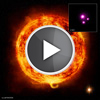CXC Home | Search | Help | Image Use Policy | Latest Images | Privacy | Accessibility | Glossary | Q&A
Tour of HD 189733
Quicktime MPEG With closed-captions (at YouTube)
HD 189733b: An exoplanet in orbit around a star about 63 light years from Earth.It has been nearly two decades since the first exoplanets - that is, planets around stars other than our Sun - were discovered. Now for the first time, X-ray observations have detected an exoplanet passing in front of its parent star. The observations, made by NASA's Chandra X-ray Observatory and the European Space Agency's XMM-Newton Observatory, took advantage of the alignment of a planet and its parent star in HD 189733. This alignment enabled the observatories to observe a dip in X-ray intensity as the planet moved in front of, or transited, the star. This technique is the one used so successfully at optical wavelengths by NASA's Kepler telescope. In earlier studies using optical light, astronomers discovered that the main star in the HD 189733 system had what is known as a "hot Jupiter" around it. This means the planet is about the size of Jupiter, but in very close orbit around its star. The planet – that has been named HD 189733b -- is over 30 times closer to its star than Earth is to the Sun, and goes around the star once every 2.2 days. The new X-ray data suggest that this planet has a larger atmosphere than previously thought. This, in turn, may imply that radiation from the parent star is evaporating the atmosphere of HD 189733b more quickly than expected. The results on HD 189733 demonstrate how we need information from many different telescopes that detect different types of light to get a fuller picture of these mysterious worlds that we are now able to explore.
[Runtime: 01:54]
Quicktime MPEG With closed-captions (at YouTube)
HD 189733b: An exoplanet in orbit around a star about 63 light years from Earth.It has been nearly two decades since the first exoplanets - that is, planets around stars other than our Sun - were discovered. Now for the first time, X-ray observations have detected an exoplanet passing in front of its parent star. The observations, made by NASA's Chandra X-ray Observatory and the European Space Agency's XMM-Newton Observatory, took advantage of the alignment of a planet and its parent star in HD 189733. This alignment enabled the observatories to observe a dip in X-ray intensity as the planet moved in front of, or transited, the star. This technique is the one used so successfully at optical wavelengths by NASA's Kepler telescope. In earlier studies using optical light, astronomers discovered that the main star in the HD 189733 system had what is known as a "hot Jupiter" around it. This means the planet is about the size of Jupiter, but in very close orbit around its star. The planet – that has been named HD 189733b -- is over 30 times closer to its star than Earth is to the Sun, and goes around the star once every 2.2 days. The new X-ray data suggest that this planet has a larger atmosphere than previously thought. This, in turn, may imply that radiation from the parent star is evaporating the atmosphere of HD 189733b more quickly than expected. The results on HD 189733 demonstrate how we need information from many different telescopes that detect different types of light to get a fuller picture of these mysterious worlds that we are now able to explore.
[Runtime: 01:54]
(Credit: NASA/CXC/J. DePasquale)
Goodness Gracious, Great Ball of Fire!
Quicktime MPEG With closed-captions (at YouTube)
Imagine you're in a spaceship, looking for a new world to settle down in. You see a planet in the distance and it's a beautiful blue color, just like Earth when it's seen from space. This planet is called HD 189733, and it is the first planet outside of our own Solar System that we've worked out the color of! But while it might look like Earth from a distance, if you flew closer to it, you'd realize just how different it is from our home.
HD 189733 is an enormous gas giant, over 100 times bigger than Earth. It orbits very close to its star. It takes Earth 365 days to orbit our Sun once, but it only takes this planet 2.2 days! In fact, it's so close to its star that temperatures in its atmosphere reach over 1000°C! No amount of sun lotion or ice cream would make this a nice place to visit.
As of today, 925 planets have been discovered orbiting around other stars in our Galaxy. But they're very small and dim, so it's not very often that we can actually see the planets. Most of the time we have to detect them using nifty tricks instead. One method is called the 'Transit Method'. We point our telescope at a star, and wait to see if it gets any dimmer. If the star does get dimmer, it means that a planet is passing in front of it and blocking some of the light. With HD 189733, astronomers have looked at the system using the Chandra X-ray Telescope to find the dip in the amount of X-rays when the planet passes in front of the star.
By doing this, they've managed to reveal some scary new details. The planet has an enormous atmosphere, which you can see in this drawing. But the boiling heat of its parent star is roasting away huge amounts of the planet's air - up to 600 million kilograms every second!
[Runtime: 02:04]
Quicktime MPEG With closed-captions (at YouTube)
Imagine you're in a spaceship, looking for a new world to settle down in. You see a planet in the distance and it's a beautiful blue color, just like Earth when it's seen from space. This planet is called HD 189733, and it is the first planet outside of our own Solar System that we've worked out the color of! But while it might look like Earth from a distance, if you flew closer to it, you'd realize just how different it is from our home.
HD 189733 is an enormous gas giant, over 100 times bigger than Earth. It orbits very close to its star. It takes Earth 365 days to orbit our Sun once, but it only takes this planet 2.2 days! In fact, it's so close to its star that temperatures in its atmosphere reach over 1000°C! No amount of sun lotion or ice cream would make this a nice place to visit.
As of today, 925 planets have been discovered orbiting around other stars in our Galaxy. But they're very small and dim, so it's not very often that we can actually see the planets. Most of the time we have to detect them using nifty tricks instead. One method is called the 'Transit Method'. We point our telescope at a star, and wait to see if it gets any dimmer. If the star does get dimmer, it means that a planet is passing in front of it and blocking some of the light. With HD 189733, astronomers have looked at the system using the Chandra X-ray Telescope to find the dip in the amount of X-rays when the planet passes in front of the star.
By doing this, they've managed to reveal some scary new details. The planet has an enormous atmosphere, which you can see in this drawing. But the boiling heat of its parent star is roasting away huge amounts of the planet's air - up to 600 million kilograms every second!
[Runtime: 02:04]
(Credit: NASA/CXC/April Jubett)
Return to HD 189733 (July 29, 2013)




